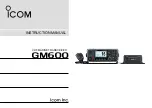
To
Recall a Frequency from memory
Press RCL. The S meter then becomes the memory location pointer.
Select the desired memory location using the tuning knob. When the
desired location is selected press RCL. The desired frequency is
recalled and the receiver returned to normal operation.
The RST key resets the microprocessor and reverts to memory
position 1.
Tune to 100 kHz and you will hear a fast ticking noise. These are the
pulses of LORAN C, this is a long range navigation system in use all
over the world. A little lower in frequency, between 80 and
90
kHz you
can hear the carriers of the DECCA system. This system was set up in
1944
for the D day landing and has been in continuous maritime use
ever since. Encrypted data is transmitted to military submarines at
VLF.
This covers very great distances. Speech is not transmitted.
The Medium and Long waves are crowded with domestic and foreign
broadcast stations. When tuning a station rotate the tuning knob to
obtain the highest number on the
Signal Strength Meter.
Tune between
300
and
400
kHz for marine and aeronautical beacons.
These are used by shipping and aircraft to get bearings. Each beacon
transmits a Morse code ident of it’s name. The Morse is very
slow and
continually repeats,
so
if
you don’t read Morse, you have plenty of time
to look it up. The ident letters are often a syllable of the airport or
towns name.
Domestic portable telephones operate at the high frequency end of the
medium wave at about 1.6 MHz. At 1.8 MHz the short wave
frequencies start. A quick flip round and you’ll find it’s very different
than the medium wave band.
The BBC broadcasts it’s World Service on several short-wave
frequencies. In times of crisis the BBC World Service has been the
source of unbiased news the world over. Most countries have their
own overseas broadcasts. Some follow in the traditions of the BBC,
others simply use the airwaves for blatant propaganda.
4



































